Abstract
The present study aims to evaluate the maximum strength of the wings and then make the difference between those from Romanian Handball League and those from Dinamo Bucharest Club. The sample of participants consisted of 16 male players divided into two groups. The first group included 16 wings (n=16) who participate in the first handball league and the second group included four wing players (n=4), which play for Dinamo Bucharest Sports Club. The maximum strength was measured using maximal repetition (1MR). A series of five 1MR tests were scheduled: Squat, Bench press, Romanian Deadlift, Power clean and Barbell Row. The results of Dinamo Bucharest's wings are superior compared to the results of other wings from national handball league, in four out of five tests. Even if there are differences, they are not statistically significant, p˃0.05 (Squat 144.18±12.15; 146±10.86 - Bench Press 100.34±8.58; 104.25±6.18 - Power Clean 67.25±9.99; 74.75±12.97 - Barbell Row 92.62±8.22; 96.00±9.83). Nevertheless, the maximum strength of the wing players from the Romanian National League is located at the top of the assessment scales specific to the strength tests. This allowed us to create an overview of the level of handball in our country, regarding the training level of the handball wings.
Keywords: 1 MR tests, handball, male, maximum strength, wings
Introduction
Sport has become an integral part of any society. The interest towards performing sports has grown more and more. Therefore, sport has become a strong social phenomenon anchored in people's lives. (Baștiurea, 2006). When we talk about performing in sports, we can't ignore the handball game. Handball is a young game, but it has quickly become appreciated and practiced due to its spectacular style that derives from the multitude of movements. This permanent development has led specialists to orient the training process according to the evolution of the modern game (Taborsky, 2008). Moreover, studies on the handball game have expanded, and specialists such as (Bompa & Buzzichelli, 2021; Bonnet et al., 2020) focused their studies on the theoretical and methodical substantiation. The role of the handball players that are playing as wings is becoming more important in handball, in all phases of the game (fastbreak, attack, balance or defence), based on collective actions (when collaborating with teammates) or individual actions. In this context, there is the issue of individualized training (Bernicu et al., 2020) especially for the young handball players (Ruscello et al., 2021), issue highlighted by Wagner et al. (2014, p. 814) who came to the conclusion that “there is a lack of training studies, especially in team-handball specific training” and also by Hermassi, Laudner et al. (2019, p. 11) who recommend coaches to “develop position-specific training concepts”. The issue of individualization highlights the importance of specialization of players on different positions, in attack and defence, taking into account the type of effort related to the motor structure of the handball game, as well as the technical-tactical content specific to the playing positions. A team that wants to have a constant value must be concerned with the style of play and the training of players in a uniform way (Cojocaru, 1956). Handball players (in this case - wings) need special technical skills and anthropometric characteristics, a high level of strength and speed (Cazan, 2018; Georgescu et al., 2019; Hermassi, Delank, et al., 2019; Mohoric et al., 2021) and also mental qualities (Hermassi, Chelly et al., 2019; Kiss & Balogh, 2019). Sotiriu (1998) considers that depending on the playing position, physical training should be a permanent concern. According to Eftene and Axinte (2012, p. 145), individualization - as a working method, "represents a form of organization of the training process". They recommend for the wings a series of means to improve their strength, speed, coordination, all carried out in a technical and tactical regime. So, individualization is "a special activity of preparing athletes according to individual characteristics" (Mihăilă, 2005, p. 39). For the handball game, we know that the bio-psycho-social characteristics of the player must be related to the technical-tactical content specific to the phases of the game for attack and defence, as well as the motor structure and dynamics of the effort specific to each game position.
Problem Statement
The current handball game pays equal attention in training to the team players, regardless of the position for which they are specialized. The identification of the current strength level of wings that play in the Romanian National League, will require a differentiated treatment of players specialized on this position, according to the motor structure and the specific effort of the modern handball game. The role and importance of all players, regardless of the position they play on, is constantly growing.
Research Questions
In our research we started from the following hypothesis: Can the identification of the maximum strength for the wing players that play in the first handball league in Romania, lead to the elaboration and implementation of new training methods, related to the motor structure and the effort’s specificity in the current handball game? Are there significant differences between the wings from other handball clubs in Romania and the wings from Dinamo Bucharest Sports Club, the only male handball team from Romania that plays in Champions League, regarding the maximum strength capacity?
Purpose of the Study
The present study is focused on evaluating the maximum strength of the wings that play in the Romanian National Handball League and compare them to those from Dinamo Bucharest – the team regarded as the best in the country. The identification of the maximum strength through the 1 MR (maximal repetition) tests will give us the possibility to elaborate a training program that would help increase the performances of the wings and implicitly of the team.
Research Methods
Participants
For this experiment we had two groups. The first group included 16 male handball players – wings (n=16). They are players from different handball clubs in the Romanian first league. The second group included four wing players (n=4), which play for Dinamo Bucharest. The inclusion criteria were: to be male, to be wing, good health status. Participants gave their consent to use these personal data for scientific purpose and the conduct of this study was approved by the University of Pitești.
Measurements and Tests
In this research we selected five tests that assess the maximal strength. The maximal strength was measured using 1MR procedure. A series of five 1MR tests were scheduled: Squat, Bench press, Romanian Deadlift, Power clean and Barbell Row. These tests are considered by specialists to be representative for assessing the performance capacity of handball players.
Procedures and Research Design
At the beginning of the experiment, we randomly chose 16 wings (from the men's handball teams that participate in the Romanian National League). Then, out of the 16 subjects, we chose the wings who are playing for Dinamo Bucharest. The next step was to establish the maximum strength of all players and then see if there are significant differences between the two groups. This allowed us to have an overview of the level of handball in our country, regarding the training's level of the wings. The maximal strength was measured using 1MR procedure. Representing the maximum repetition that can be achieved, the 1MR tests have a high degree of fidelity in order to establish the maximum level of muscle strength. During each trial, the greatest weight lifted or pressed for each exercise was identified as the 1RM.
Data analyses
For the statistical analysis, we used mean—X, standard deviation—SD and coefficient of variability. To render the statistical significance of the differences we used the Student Test. The independent t test was calculated to see if the means of the two samples, respectively the group of players from the teams in the National League (n = 16) and those from Dinamo Bucharest Sports Club (n = 4) differ significantly. The t value results were compared with the t critical value from the Fisher table. The degree of freedom was n – 2; (16 + 4) – 2 = 18.
Findings
The results of the descriptive data of all participants are presented in Tables 1 and 2. Table 1 shows the means (X), standard deviations (SD) and the coefficient of variability (CV%) of the wings who are playing in the Romanian National Handball League. Table 2 shows the X, SD and CV (%) of the wing players from Dinamo Bucharest. Also in table 2, is presented the intergroup analysis - t-values were calculated based on the collected data, in order to determine if there are significant differences between the two study groups.
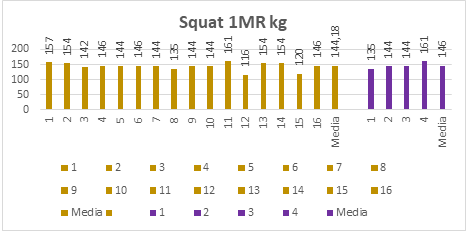
As seen in Figure 1, 1 MR Squat Test reveals that the results of the wing players from National League were between 116 kg and 161 kg with a mean of 144.18±12.15 and a coefficient of variability of 8.42, which indicates a high homogeneity of the group. The mean of the wings from Dinamo Bucharest (146 ± 10.86) is higher than that of the wings from the National League and the CV% = 7.44 indicates a high homogeneity. The t-value (-0.29) shows that there are no statistically significant differences, p ˃0.05.
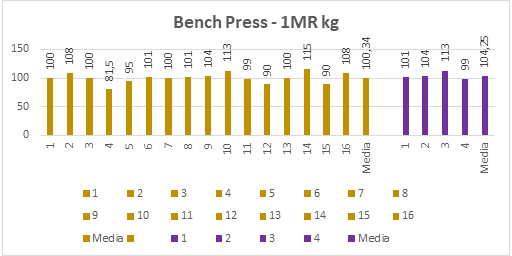
Figure 2 reveals that for the 1 MR Bench Press Test the wing players from National Handball League had values between 81.5 kg and 115 kg, with a mean of 100.34±8.58 and a coefficient of variability of 8.55, which indicates a high homogeneity of the group. The mean of the wings from Dinamo Bucharest (104.25 ± 6.18) is higher than that those from the first group and the CV% = 5.93 indicates a high homogeneity. The t-value (-1.03) shows that there are no statistically significant differences, p ˃0.05.
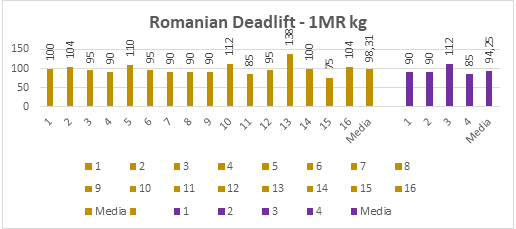
Results represented in Figure 3 for the 1 MR Romanian Deadlift Test show that the mean of the first evaluated group was 98.31±14.14. The coefficient of variability = 14.38 indicates an average homogeneity of the group. The mean of the wings from Dinamo Bucharest (94.25 ± 12.06) is smaller than that of the wings from the National League, but the coefficient of variability = 12.80 indicates a high homogeneity. The (0.58) shows that there are no statistically significant differences, p ˃0.05.
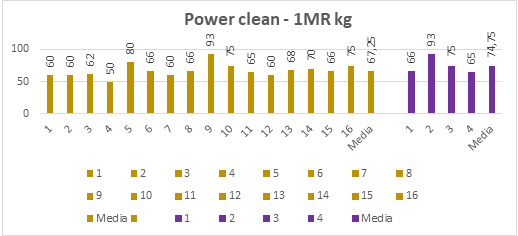
Figure 4 shows that for the 1 RM Power Clean Test, the mean of the results for wing players from Romanian National Handball League was 67.25±9.99. The coefficient of variability = 14.86 indicates an average homogeneity of the group. The mean of the wings from Dinamo Bucharest Sports Club (74.75 ± 12.97) is higher than that of the wings from the other handball clubs in Romania and the CV% = 17.35 indicates an average homogeneity. The (1.07) shows that there are no statistically significant differences, p ˃0.05.
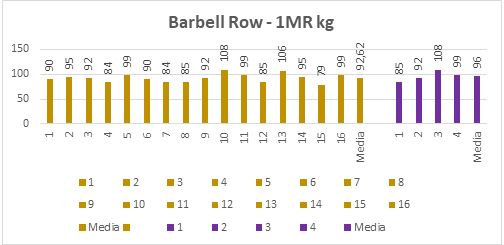
Looking at figure 5, we can notice that for the 1 MR Barbell Row Test, the results of the wing players from National Handball League were between 79 kg and 106 kg with a mean of 92.62±8.22 and a coefficient of variability of 8.87, which indicates a high homogeneity of the group. The mean of the wings from Dinamo (96.00 ± 9.83) is higher than that of the wings from the National League and the CV% = 10.24 indicates an average homogeneity. The (0.63) shows that there are no statistically significant differences, p ˃0.05.
Conclusions
The maximal strength level of the wing players in the research is quite close, there are no significant differences between the results obtained. The strength capacity of the handball players specialized on the wing position in the Romanian National Handball League is located at the top of the specific assessment scales for the strength tests applied. The results of Dinamo Bucharest's wings at the maximum strength tests are superior compared to the results of the other players in the national handball league, in four control tests out of a total of five confirming the results of Lijewski et al. (2021, p. 9) who noticed in their study that “the highest ranked athletes were characterized by a significantly more massive physique, considered an advantageous characteristic in direct competition”. Even if there are differences between the performances obtained by the two groups, the “t” calculated values show us that they are not statistically significant for the wing players from the two groups, p˃0.05.
References
Baștiurea, E. (2006). Handbal. Perfecționare într-o ramură sportivă [Handball-Perfection in a sports branch]. Academica.
Bernicu, R., Mihăilă, I., & Mihăilescu, N. (2020). Contributions to the Technical Training of Handball Players in the Wing Post. ARENA- Journal of Physycal Activities, 9, 137-146.
Bompa, T., & Buzzichelli, C. A. (2021). Periodizarea. Teoria și metodologia antrenamentului [Periodization. Theory and methodology of training]. Lifestyle.
Bonnet, G., Debanne, T., & Laffaye, G. (2020). Toward a better theoretical and practical understanding of field players’ decision-making in handball: A systematic review. Movement & Sport Sciences - Science & Motricité, 110, 1-19. DOI:
Cazan, F. (2018). Aprofundare intr-o ramură sportivă. Pregătirea fizică specifică în handbal [In- depth in a sport specific. Physical training in handball]. Universitaria.
Cojocaru, V. (1956). Training handball teams. Tineretului, cultură fizica si sport [Youth, physical culture and sport].
Eftene, A., & Axinte, A. (2012). Handbal. Exerciții combinate pentru pregătirea integrală [Handball. Combined exercises for full preparation]. Alma Mater.
Georgescu, A., Varzaru, C., & Rizescu, C. (2019). Improving Speed to Handball Players. Romanian Magazine for Multidimensional Education, 11(1). DOI:
Hermassi, S., Chelly, M. S., Wagner, H., Fieseler, G., Schulze, S., Delank, K.-S., Shephard, R. J., & Schwesig, R. (2019). Relationships between maximal strength of lower limb, anthropometric characteristics and fundamental explosive performance in handball players. Sportverletzung · Sportschaden, 33(02), 96-103. DOI:
Hermassi, S., Delank, K. S., Fieseler, G., Bartels, T., Chelly, M. S., Khalifa, R., Laudner, K., Schulze, S., & Schwesig, R. (2019). Relationships Between Olympic Weightlifting Exercises, Peak Power of the Upper and Lower Limb, Muscle Volume and Throwing Ball Velocity in Elite Male Handball Players. Sportverletzung · Sportschaden, 33(02), 104-112. DOI:
Hermassi, S., Laudner, K., & Schwesig, R. (2019). Playing Level and Position Differences in Body Characteristics and Physical Fitness Performance Among Male Team Handball Players. Front. Bioeng. Biotechnol, 7, 149. DOI:
Kiss, B., & Balogh, L. (2019). A study of key cognitive skills in handball using the Vienna test system. Journal of Physical Education and Sport, 19(1), 733-741.
Lijewski, M., Burdukiewicz, A., Stachoń, A., & Pietraszewska, J. (2021). Differences in anthropometric variables and muscle strength in relation to competitive level in male handball players. PLoS ONE, 16(12), e0261141. DOI:
Mihăilă, I. (2005). Profilul jucătorilor pe posturi și implicațiile lui în realizarea condiției fizice la handbaliștii juniori [The profile of the players on the positions and its implications in achieving the physical condition at the junior handball players]. [Phd thesys].
Mohoric, U., Sibila, M., & Strumbelj, B. (2021). Positional dofferences in some physiological parameters obtained by the incremental field endurance test among elite handball players. Kinesiology, 53(1), 3-11.
Ruscello, B., Castagna, C., Carbonara, R., Gabrielli, P. R., & D’Ottavio, S. (2021). Fitness profiles of elite male italian teams handball players. J Sports Med Phys Fitness, 61(5), 656-665. DOI: 10.23736/S0022-4707.21.11850-X.
Sotiriu, R. (1998). Handbal antrenament, teorie – metodică [Handball training, theory – methodical]. Gapold.
Taborsky, F. (2008). Cumulative indicators of team playing performance in handball (Olympic Games Tournaments 2008). EHF Web Periodical. http://home.eurohandball.com/ehf_files/Publikation/WP_Taborsky_OCGChina.pdf
Wagner, H., Finkenzeller, T., Würth, S., & Von Duvillard, S. P. (2014). Individual and Team Performance in Team-Handball: A Review. Journal of Sports Science and Medicine, 13, 808-816.
Copyright information

This work is licensed under a Creative Commons Attribution-NonCommercial-NoDerivatives 4.0 International License.
About this article
Publication Date
10 April 2023
Article Doi
eBook ISBN
978-1-80296-961-0
Publisher
European Publisher
Volume
5
Print ISBN (optional)
-
Edition Number
1st Edition
Pages
1-1463
Subjects
Education sciences, teacher education, curriculum development, educational policies and management
Cite this article as:
Gavriloaia, A. R., Mihăilă, I., Mihai, I., & Popescu, D. C. (2023). Maximum Strength Level of the Wings From the Romanian Handball League. In E. Soare, & C. Langa (Eds.), Education Facing Contemporary World Issues - EDU WORLD 2022, vol 5. European Proceedings of Educational Sciences (pp. 1254-1261). European Publisher. https://doi.org/10.15405/epes.23045.126

